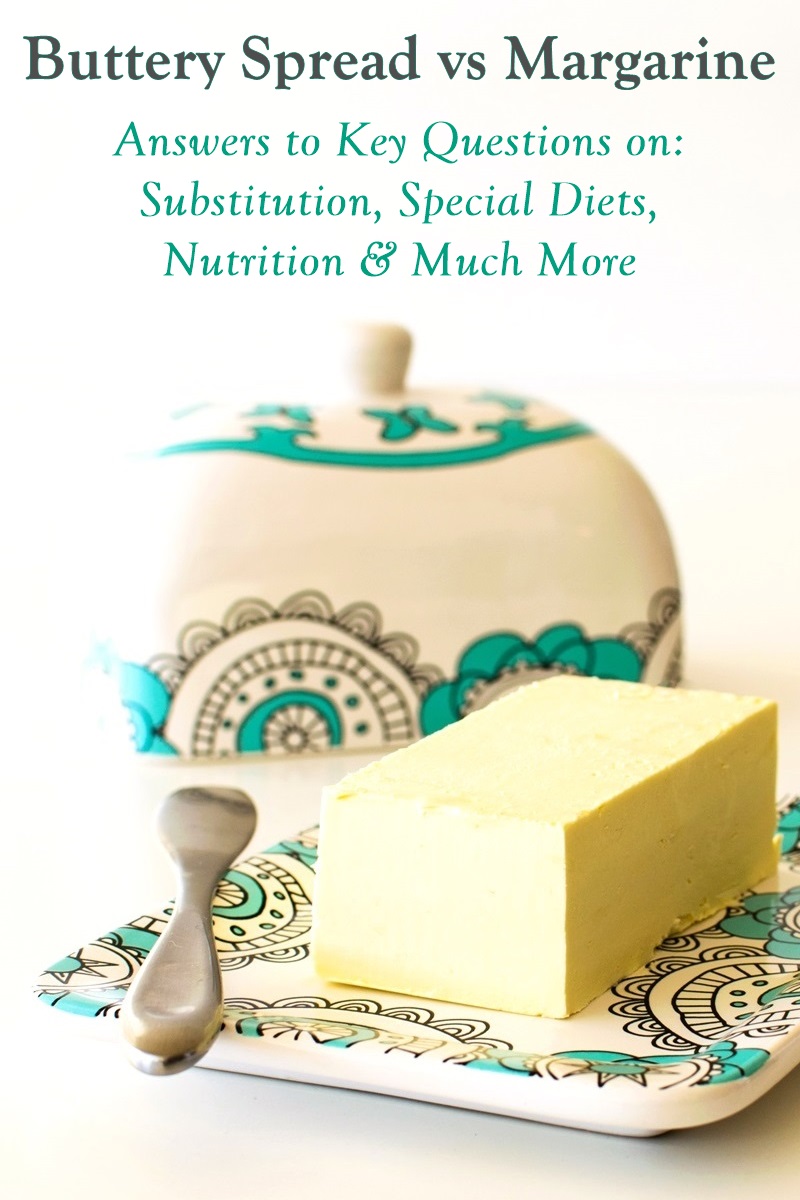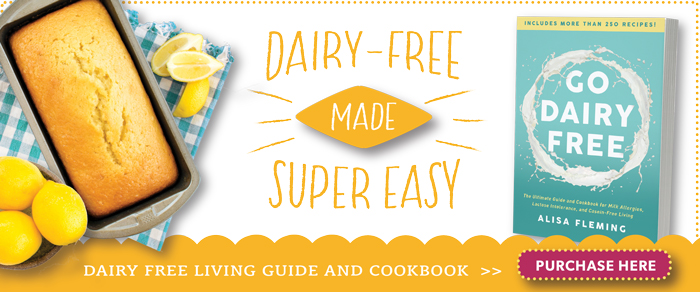We’re getting deep into the holiday season, and I want to make sure every dairy-free cookie, biscuit, and pie from your kitchen is perfect! So today I’m addressing a topic of increasing confusion: buttery spread (and sticks) vs margarine.
In this post, I’ll answer all of the following questions (tip: click on each question to jump to the answer).
- What’s the Difference between Buttery Spread and Margarine?
- Are Buttery Spreads and Sticks Always Dairy Free?
- Can you Substitute Margarine for Buttery Spread in a Recipe?
- Can I Make My Own Buttery Spread?

What’s the Difference between Buttery Spread and Margarine?
By basic definition, buttery spread is margarine. But the USDA defines them differently, and those differences might affect your choice at the store.
What is Margarine?
Margarine is an emulsion of fat and water that’s made to mimic the taste and performance of butter. It sometimes contains a small quantity of dairy to augment the butter-like properties.
You might think of margarine as a U.S. invention, but it was actually developed in France in 1869 as an inexpensive butter substitute. Margarine gained popularity in the U.S. during World War II, when there was a butter shortage. It continued as a staple long after the war in budget-minded households and with food manufacturers who needed a stable butter alternative with a cheap price point.
For most of its history, margarine was made with saturated fat, which is solid at room temperature. This made it easy to create a soft, spreadable, and stable consistency. But in the 1970s and 1980s, when saturated fat was villainized, margarine began its plant-based transition.
In 1996, the USDA imposed regulations on margarine that would solidify its unsaturated standing. They require that margarine must be composed of 80% or more fat from canola, safflower, sunflower, corn, soybean, and/or peanut oil.
This might sound like a health win for plant-based promoters, but there was a catch. All of those oils are liquid, even when chilled. To combat this issue, manufacturers partially hydrogenated the vegetables oils to mimic the consistency of saturated fat. In order to fit the USDA requirements, margarine transformed from a saturated fat product to a trans-fat product.
But in 2018, the FDA instituted a ban on partially hydrogenated oils in the U.S. to help reduce consumption of trans fats. It took full effect in 2020, and has promoted many margarine makers to shift to buttery spread and stick formulations.
What is Buttery Spread?
By general definition, buttery spread is margarine. But according to the USDA, buttery spread is a much broader term. Buttery spreads emerged when brands began subverting the trans fat problem and creating functional butter alternatives. To keep them reigned in, the USDA released formal guidelines for buttery spreads in 2008.
Buttery spreads do not have a minimum fat percentage, so they can be available in “light” and “trans fat-free” varieties. They still have to be plant-based (they can’t have more than a trace amount of cholesterol). But they can have up to 5 grams of saturated fat and the plant oil types aren’t restricted. This means buttery spreads can use plant oils that solidify at room temperature, like coconut oil or palm oil, instead of relying on partially-hydrogenated oils.
What are Buttery Sticks?
Buttery sticks fall under the USDA’s buttery spread guidelines. So in theory, buttery spread and buttery sticks might only differ in their packaging. Some people like the stick format because it’s easier to measure for recipes.
But companies usually formulate buttery sticks to be better for baking, like stick margarine. They tend to be very similar to the brand’s buttery spread line, but have a slightly different recipe to make them just a touch more stable. I frequently use buttery sticks to test recipes like cookies, pie crust, and frosting, where stability is more important.
What is Vegan Butter?
Vegan butter, or plant butter, is another term used by butter alternative makers. In some cases, it’s just another name for buttery spread or sticks, but some brands are using it as a new term to help subvert any regulations on fat. Certain butter alternatives are made primarily of solid oils, like coconut and palm oil, so they have much higher saturated fat than what is permitted in margarine, buttery spreads, or buttery sticks.
There aren’t any regulations on this specific term, but it could be banned at some point. Dairy proponents are trying to get legislation enacted that would prevent dairy-free brands from using labels like “butter.”
Are Buttery Spreads and Sticks Always Dairy Free?
No, like margarine, buttery spreads and sticks can contain dairy. There is no regulation that restricts dairy from these products, and manufacturers use various types of dairy to make their products taste and feel more buttery. For example, Brummel & Brown Buttery Spreads are made with yogurt for a creamy consistency without high fat and Land-O-Lakes adds buttermilk for “fresh buttery taste.” Some brands simply use natural flavors that contain dairy.
Nonetheless, you will usually find more plant-based and dairy-free brands among the buttery spreads. Dairy-free margarine definitely exists, but the flexible guidelines of buttery spreads allow for more dietary innovation. See our Buttery Alternatives Listings for dairy-free options.
Can you Substitute Margarine for Buttery Spread in a Recipe?
You definitely can. In fact, some recipes will perform better with margarine. You may (or may not) prefer the taste of the buttery spread, but like it or not, hydrogenated oils hold up very well when baked. It’s more a matter of preference, taste, and budget for your household. Buttery spread tends to be more expensive than margarine, but they are also usually free of artificial trans fats.
But the needs of a severe food allergy always come first. Check with the company to find out what is safe for your needs. I know many food allergy parents who are loyal to certain margarine brands for allergy safety and performance, but others who love their buttery spreads.
Can I Make My Own Buttery Spread?
Yes, you can! In fact, the picture in this post shows my Bakeable Butter Recipe in Go Dairy Free: The Ultimate Guide and Cookbook (2nd Edition). It’s surprisingly easy to make a creamy emulsion that works in recipes, and is also a great way to control the ingredients. Not to mention, there are no USDA regulations on homemade recipes! Homemade Bakeable Butter works quite well in most recipes, including cookies and pie crusts!

